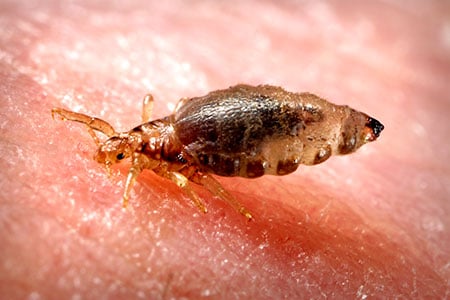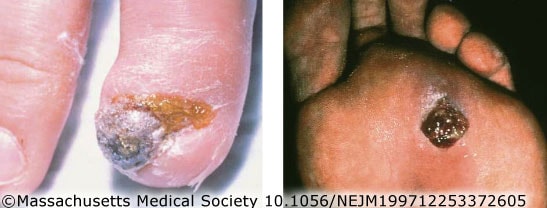Bartonella quintana infection
Transmission

Body louse on human skin
People can get Bartonella quintana from the bite of the human body louse. Body lice spread by close physical contact or by repeatedly using the same clothes or bedding. B. quintana infection is most commonly associated with body louse infestations in areas of high population density and poor sanitation. People experiencing homelessness are at increased risk of developing infection with B. quintana because of limited access to shower and laundry facilities. B. quintana infection occurs worldwide. During the first World War, infection with B. quintana was referred to as “trench fever” due to the many cases among soldiers who lived in crowded trenches in poor hygienic conditions.
Signs and symptoms
- Fever (may occur once or repeatedly)
- Bone pain (mainly in the shins, neck, and back)
- Skin lesions called “bacillary angiomatosis”
Bacillary angiomatosis primarily affects people with weakened immune systems, such as those with advanced HIV infection. Bacillary angiomatosis can present as vascular lesions in the skin, under the skin, in bone, or in other organs.

Endocarditis
As with many Bartonella species, B. quintana can sometimes cause infection of the heart valves (endocarditis). In many cases, blood cultures might be negative (culture-negative endocarditis), which can make the diagnosis more challenging.
Prevention
- Avoid exposure to human body lice. Body lice are typically associated with crowded living conditions and limited access to bathing and clean clothes.
- Do not share clothing, beds, bedding, or towels used by a person who might have body lice.
- Access to regular showers and laundry services is critical to prevent quintana infection among people living in congregate shelters or who lack access to housing.
- When washing clothes or bedding that may be infested with body lice, use hot water above 55 degrees Celsius (130 degrees Fahrenheit) and dry on high heat to kill lice and their eggs.
- Information about treating body lice is also available.
Diagnosis and testing
- B. quintana is a fastidious, slow-growing bacterium. Cultures should be held for a minimum of 21 days. It is often helpful for providers to alert the microbiology laboratory that B. quintana is suspected to optimize conditions for growth.
- Serology can aid the diagnosis of B. quintana, although cross-reactivity with other Bartonella species may limit interpretation. Providers should be aware that serological tests do not reliably differentiate among Bartonella species and positive results may persist for years even after effective treatment.
- Molecular detection (including PCR) can be particularly useful in cases of culture-negative endocarditis. Patients with infectious endocarditis sometimes have damaged heart valves that need to be surgically replaced. Molecular detection of Bartonella spp. should be performed on excised heart valve tissue if a patient with endocarditis requires surgical valvular replacement. For patients with suspected B. quintana bacteremia, PCR testing can also be performed on blood.
Treatment
Infection with B. quintana requires antibiotic treatment. A number of antibiotics are effective against Bartonella infections, including tetracyclines, aminoglycosides, and macrolides. More than one antibiotic is often used. Consult with an expert in infectious diseases regarding treatment options.